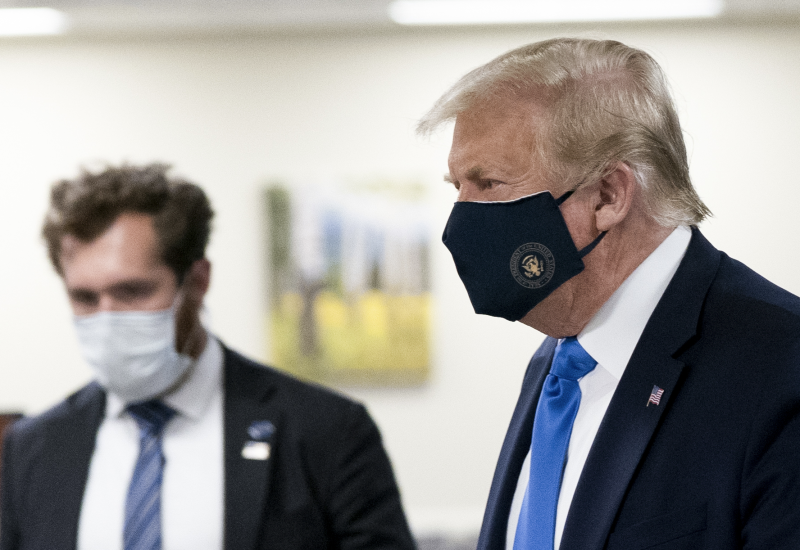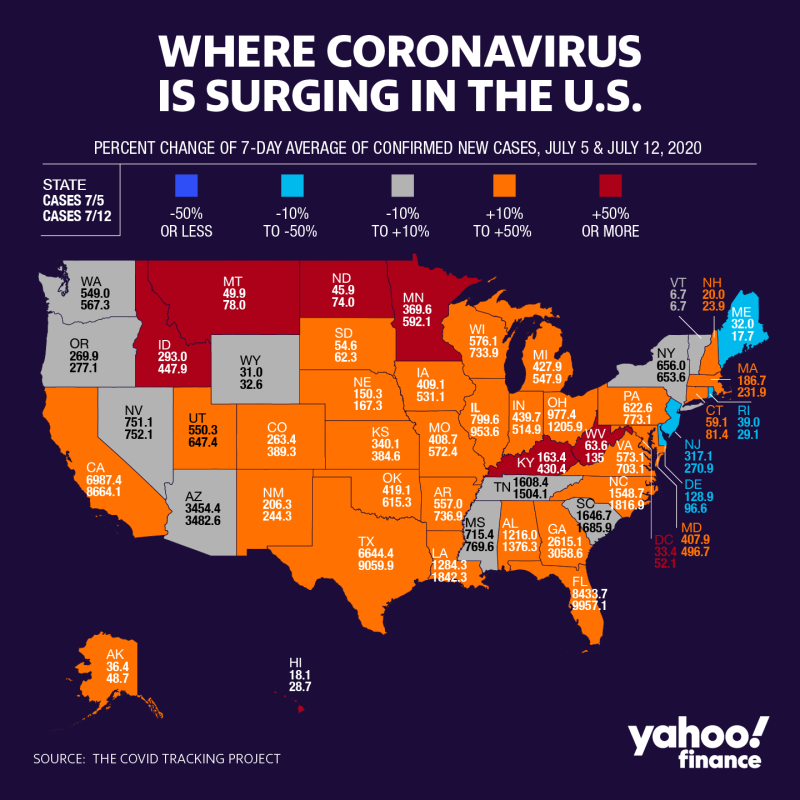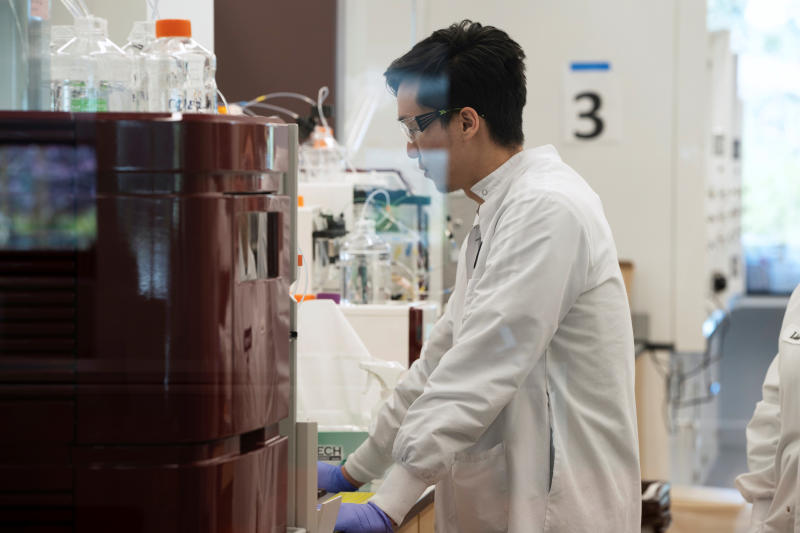
COVID-19
Updates on the emerging novel coronavirus pandemic from the Johns Hopkins Center for Health Security.
The Center for Health Security is analyzing and providing updates on the emerging novel coronavirus. If you would like to receive these updates, please subscribe below and select COVID-19. Additional resources are also available on our website.
EPI UPDATE The WHO COVID-19 Situation Report for July 19 reports 14.04 million cases (166,735 new) and 597,583 deaths (4,496 new). This is the lowest daily incidence reported since July 1; however, it includes zero new cases reported by the US. With the expected number of US cases, the global daily incidence would be closer to 230-240,000 cases. The WHO reported the global record high of 259,848 new cases on July 18. The pandemic has been ongoing for more than 6 months and continues to accelerate.
Brazil reported 23,529 new cases, falling to #3 globally in terms of daily incidence. Two weeks ago (Week 28), Brazil’s weekly incidence was nearly identical to the previous week, and last week (Week 29), Brazil reported its first noticeable decrease in weekly incidence—down from 262,846 new cases to 235,010. The daily incidence still appears to be relatively consistent over the past 3 weeks; however, this could indicate that Brazil has passed its first peak. Colombia reported 6,578 new cases, and its epidemic continues to accelerate. Colombia is currently #5 globally with respect to daily incidence, and Mexico (5,311 new cases) is #6. Broadly, the Central and South American regions are still major COVID-19 hotspots. Including Brazil, Colombia, and Mexico, the region represents 5 of the top 11 countries globally in terms of daily incidence, along with Peru (#8) and Argentina (#10). Additionally, 10 countries in the Americas, including the US and the Caribbean, are reporting more than 100 daily cases per million population.
India reported its highest daily incidence to date, with 40,425 new cases, exceeding 40,000 new cases for the first time. India surpassed Brazil to become #2 globally in terms of daily incidence. India’s daily incidence has more than doubled since the beginning of July and appears to be increasing exponentially. Bangladesh continues to report slowly decreasing daily incidence; however, it is also reporting decreased testing while its test positivity remains slightly above 20%. This could indicate that Bangladesh's decreased incidence could be driven more by reduced testing than slowing transmission. Bangladesh is #9 globally in terms of daily incidence.
South Africa reported 13,449 new cases, and it remains among the top countries globally in terms of both per capita and total daily incidence.
Overall, the Eastern Mediterranean region remains a global COVID-19 hotspot. In total, at least 20 countries globally are reporting more than 100 daily cases per million population, and 4 of those—Bahrain, Kuwait, Oman, and Qatar—are in the Eastern Mediterranean region. Additionally, nearby Armenia and Israel (WHO European region) are also reporting more than 100 daily cases per million population. Saudi Arabia is #11 globally in terms of total daily incidence.
After its first peak, Australia appeared to gain control of its COVID-19 epidemic; however, transmission has surged in recent weeks. At more than 300 new cases per day, Australia’s daily incidence is approaching the level reported during its first peak. In nearby New Zealand, daily totals have not exceeded 3 new cases since the country declared the disease eliminated in early June.
UNITED STATES
The US CDC reported 3.70 million total cases (67,574 new) and 139,659 deaths (877 new). In total, 25 states and New York City have reported more than 40,000 total cases, including California with more than 375,000 cases; Florida and Texas with more than 300,000; New York City with more than 200,000; and 7 additional states with more than 100,000. The US is currently averaging more than 750 deaths per day, and it could reach 150,000 cumulative deaths in the next 2 weeks.
New York, including New York City, has reported the most COVID-19 cases of any US state, with 406,807 total cases; however, California, Florida, and Texas continue on pace to surpass this total in the coming days. California is reporting an average daily incidence of 8,323 new cases per day; Florida is reporting 11,461 new cases per day; and Texas is reporting 9,886 new cases per day. New York is reporting fewer than 750 new cases per day, so we can expect California to surpass New York by the middle of this week, Florida by the end of this week, and Texas by the middle of next week.
The Johns Hopkins CSSE dashboard reported 3.79 million US cases and 140,716 deaths as of 1:00 pm on July 20.
US COVID-19 RELIEF BILL Some portions of US COVID-19 relief funding are expiring soon, and efforts are ongoing to evaluate the possibility of another round of stimulus funding. In particular, previous COVID-19 funding bills provided for increased unemployment insurance—an extra US$600 per week—which will expire next week. Additionally, a federal moratorium on some evictions will also expire, which would put many individuals and families at risk of losing their homes, particularly those who remain unemployed. The expiration of state-level eviction moratoria are already resulting in substantial volumes of eviction proceedings in some states. Many individuals have used the extra unemployment funding to pay bills, including rent, and they may not be able to continue making their required payments without an extension or other federal funding support.
With many Americans still unable to return to work—due to a variety of factors, including temporary or permanent closure of their business, remaining social distancing restrictions, children still home from school, or a lack of available jobs—federal lawmakers are discussing potential options for another stimulus package. There is some evidence that the expanded unemployment funding is allowing some individuals to make more money than if they were working, which could complicate decisions regarding when and how to return to work. Concerns about rising federal debt and potential misuse of federal funding are factoring into these plans.
While the negotiations involve many complex issues and decisions, there are several primary proposals and areas of contention with respect to how future funding would be distributed. Democrats in the House of Representatives previously passed a US$3 trillion funding package that included a broad range of support for individuals, businesses, state and local governments, and hospitals; however, the bill never received a vote in the Senate. Senate Majority Leader Mitch McConnell has indicated that Senate Republicans are drafting their own legislation, potentially more limited in scope and funding, could be unveiled this week. One of Senator McConnell’s stated priorities is liability protection for businesses, including hospitals, to protect them against lawsuits following COVID-19 infections among employees or patrons. Speaker of the House Nancy Pelosi emphasized the need for direct payments and extended unemployment insurance for individuals to ensure they have funds available for rent, food, and other necessities, but there are differing opinions regarding how best to accomplish it and who could be eligible. Additionally, US President Donald Trump has called for a payroll tax cut for businesses; however, there appears to be some opposition to this mechanism from both Republicans and Democrats. While a payroll tax cut could reduce financial burden on businesses, it could also reduce federal funding for programs such as Social Security.
CHILDREN & SCHOOLS As the US school year rapidly approaches, federal, state, and local government officials are working to develop and implement plans to resume classes. Proposals range from full-time, in-person classes to online/remote classes only, including a myriad of hybrid options in between. Much of the uncertainty and debate revolves around the direct risk to children and the role they play in community transmission. It is generally understood that children are at lower risk for severe COVID-19 disease and death than adults—although, certainly not zero risk—but it is much less clear how easily children transmit the infection to others, including adults or other high-risk individuals at home or in the community.
A recent study by researchers in South Korea, published in the US CDC’s Emerging Infectious Diseases journal, found that SARS-CoV-2 transmission was far more common in household settings compared to public settings. Based on analysis of more than 59,000 contacts of more than 5,700 COVID-19 “index patients,” the researchers found that household contacts were more than 6 times more likely to become infected than non-household contacts. The study identified cases in 11.8% of household contacts, compared to only 1.9% of non-household contacts. Notably, households with an “index patient” aged 10-19 years were at even higher risk for transmission—cases identified in 18.6% of household contacts, compared to 11.8% in households with “index patients” of other ages. The lowest transmission risk among household contacts was for “index patients” aged 0-9 years. In these households, cases were identified in only 5.3% of household contacts; however, this was still greater than the overall risk for non-household contacts. This indicates that children who are infected at school could transmit the infection at home more easily than in other settings, particularly for older children, which would put other family members at increased risk. The study only evaluated symptomatic cases, so further evaluation is required to better characterize the role of asymptomatic or pre-symptomatic transmission by children.
It appears that there may be significant risk of transmission by children as they return to in-person classes, and many schools are evaluating options for remote/online classes this fall. Other options include home schooling, which some parents are investigating after positive experiences with remote classes this spring after most schools closed. While these options may appear similar on the surface, remote classes and home schooling are very different. Home school options vary widely, including utilizing existing curricula or developing personalized course work, and the standards and requirements vary from state to state. While online classes and home school may be effective, they may not be viable options for everyone. These options may require computers, tablets, or smartphones and reliable high-speed internet service to fully participate, particularly for live-streamed classes or video sessions. Availability for both computers and internet services may not be feasible for lower-income families or those living in remote areas, and many parents may not be able to continue to work remotely or remain at home in order to supervise their children during the day.
CANDIDATE THERAPEUTICS Synairgen, a biotechnology company based in the UK, announced preliminary findings from Phase 2 trials of a candidate treatment for hospitalized COVID-19 patients. The therapeutic, dubbed SNG001 for now, is an aerosolized formulation of interferon beta, a protein commonly found in humans’ innate immune system and found to be protective against respiratory viruses. The study—a double-blind, placebo-controlled clinical trial—involved 100 hospitalized patients. Patients receiving the experimental therapeutic were more than twice as likely to recover and exhibited a 79% reduction in progression to severe disease. These results were reported by Synairgen via a press release and have not been peer-reviewed. The trial also includes 120 non-hospitalized COVID-19 patients, but the data for that portion of the trial has not yet been published.
Researchers published data from the UK RECOVERY clinical trial for dexamethasone in TheNew England Journal of Medicine. Findings from the trial were previously summarized in a press release that described the drug’s effect in reducing mortality in severe COVID-19 patients. The study involved 2,104 hospitalized patients in the treatment arm and 4,321 patients in the control arm (ie, current standard of care). Overall, the study found that dexamethasone reduced mortality by 17%, adjusted for age. Notably, patients treated with the drug exhibited a statistically significant decrease in mortality among those receiving supplemental oxygen or mechanical ventilation but not for those receiving no respiratory support treatment. Dr. H. Clifford Lane and Dr. Anthony Fauci co-wrote a commentary in support of the RECOVERY trial results, emphasizing the importance of robust study designs, as opposed to relying on anecdotal evidence, in order to effectively evaluate candidate vaccines, therapeutics, and prophylactics.
CANDIDATE VACCINES Two studies were published in The Lancet, describing results of clinical trials for candidate vaccines from China and the UK. The candidate from Chinese pharmaceutical manufacturer CanSino is a single-dose vaccine that utilizes a recombinant adenovirus vector. The associated trial was a randomized, double-blind, placebo-controlled Phase 2 trial that involved 508 healthy human volunteers in Wuhan, China. Two dosages were tested, and both demonstrated high seroconversion after 4 weeks (96% and 97%, respectively) and significant neutralizing antibody response. Severe adverse reactions were reported in 9% of those receiving the higher dose and 1% of those receiving the lower dose, a statistically significant difference. Based on these results, the researchers intend to conduct a Phase 3 trial for the lower vaccine dose in the near future.
The candidate from the UK utilizes a chimpanzee adenovirus vector, created through a collaboration between Oxford University and AstraZeneca. The randomized Phase 1/2 trial was single-blinded and utilized a meningococcal conjugate vaccine as a control. The researchers administered the candidate vaccine to 543 healthy adults—533 receiving a single dose and 10 receiving a prime-boost formulation. No serious adverse reactions were reported, and adverse events were reduced among individuals who also received paracetamol (also known as acetaminophen) prohpylactically. The results indicate that the vaccine induced both T-cell and anti-spike IgG immune responses, and the anti-spike IgG response increased following the boost vaccination among those who received it. Neutralizing antibody responses were detected in 91% of individuals after a single dose—and 100% of individuals following the booster dose, for those who received it. According to the researchers, “these results...support large-scale evaluation of this candidate vaccine in an ongoing phase 3 programme.”
The UK government announced that it reached an agreement with multiple pharmaceutical companies to secure 90 million doses of candidate vaccines. This includes 30 million doses of an mRNA vaccine from BioNTech and Pfizer as well as 60 million doses of an inactivated whole-virus vaccine from Valneva (with an option to acquire an additional 40 million doses from Valneva). The UK government also secured 1 million doses of neutralizing antibodies from AstraZeneca for immunocompromised individuals who may not be able to receive a vaccination due to concerns about potential adverse events.
SOUTH AFRICA SHORTENS ISOLATION PERIOD South Africa announced that it is shortening its isolation period for COVID-19 patients from 14 days to 10 days. The update is based on data that indicates that mild COVID-19 cases are typically only infectious for 8-9 days after symptoms onset. The announcement states that the 10 days will apply from symptom onset for mild cases, but it will begin after severe patients are clinically stable (ie, no longer requiring supplemental oxygen or mechanical ventilation) in order to account for uncertainty regarding the infectious period in severe cases, consistent with the previous iteration of the guidance. Asymptomatic individuals who test positive can be removed from isolation 10 days after their positive test.
This update largely aligns with current US CDC and WHO guidance, both of which recommend a minimum of 10 days after symptom onset. Both the US CDC and WHO also include a recommended minimum time after symptoms improve or resolve before being removed from isolation. The US CDC recommends that patients be afebrile for 24 hours and exhibit improving symptoms before being removed from isolation, and the WHO recommends a minimum of 10 days after symptom onset, plus an additional 3 days without fever or other symptoms (ie, a minimum of 13 total days) for symptomatic patients.






